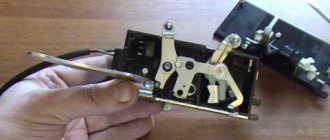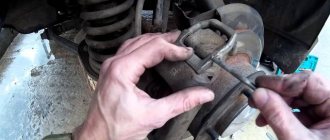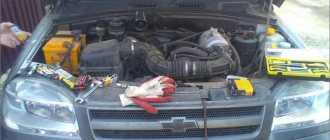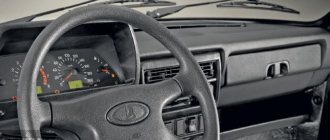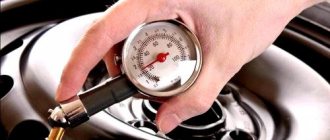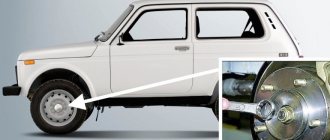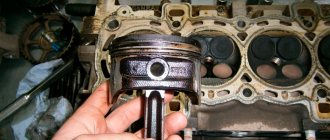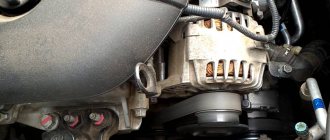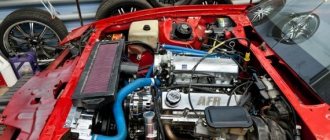The transition from adjusting bolts to hydraulic compensators (HC) made it possible to abandon the need to adjust thermal clearances every 10 thousand kilometers. The operating principle of hydraulic compensators, as well as their diagnostics, are described in the article Why hydraulic compensators knock when hot and cold. In this article we will talk about how to change hydraulic compensators on a Chevrolet Niva with your own hands. Such a replacement is necessary if the problem is not in the oil system or inappropriate engine oil, but in the malfunction of these parts. Niva Chevrolet hydraulic compensators often cause trouble for car owners - valves knock, the engine begins to work intermittently.
Description of the hydraulic compensator device and its principle of operation
Hydraulic compensators are designed to automatically regulate the thermal gap between the valves and the engine camshaft. The hydraulic attachment is provided by oil, which enters the expansion joints under pressure, and a complex and incredibly precise set of springs provides the necessary clearance.
Hydraulic compensators, which have been installed on Chevrolet Niva in recent years, give them a tangible advantage:
- there is no need to periodically adjust the valves;
- now the timing belt works more clearly and correctly;
- The noise when the engine is running has decreased significantly; it begins to knock less;
- The service life of timing parts has increased significantly.
Main details of the unit:
- Plunger pair.
- Frame.
- Plunger bushing.
- Plunger spring.
- Plunger ball valve.
The operating principle of the unit is relatively simple and consists of three main functions:
- There remains a small gap between the camshaft cam and the compensator, which is filled with oil. The plunger spring pushes the plunger out of the sleeve, the oil fills the gap under pressure, reaches the desired level, and the ball valve shuts off the oil supply. After these actions, the gap disappears.
- By turning, the cam moves the compensator down. Due to the accumulated oil, the plunger pair becomes rigid and presses on the valve, opening it.
- As the plunger moves down, it loses some oil and its pressure drops. As the cam moves further, the cycle repeats.
Types of hydraulic compensators
At the beginning of the production of Chevrolet Niva cars, old-style compensators were installed, and in the fall of 2008, a modified, new version of this part began to be installed.
Hydraulic compensators Niva Chevrolet old model
Until 2005, General Motors supplied its own expansion joints, which were of impeccable quality. But then the domestic “hydriki” came along, and the problems began. The quality of the supplied parts left much to be desired; the metal from which the parts were made was raw and did not have a long service life.
New Generation
The end of 2008 was marked by the appearance of a new generation of hydraulic compensators among Chevrolet Niva assemblers. At first, about two years, there were no problems, the parts were of good quality, the metal was hardened and wear-resistant. And then the same story began as with the old ones - the glasses became “half-baked” and could not serve their owners for a long time.
Depending on the design of the timing mechanism (gas distribution mechanism), several types of hydraulic compensators are distinguished:
- hydraulic pushers;
- roller hydraulic pushers;
- hydraulic supports;
- hydraulic supports, which are installed in rocker arms or levers.
How to identify a faulty hydraulic compensator
To determine a knocking compensator, you need to use a screwdriver, which is used as a lever, to press on those “hydraulics” that are at TDC (top dead center). If the hydraulic compensator fails under pressure from a screwdriver, it means it is not adjusted. If you want to make sure of this, quickly press with a screwdriver and you will hear a characteristic sound.
Typical faults
Problems with hydraulic compensators arise for two reasons. It is not difficult to identify them - this is either a mechanical breakdown of the unit itself, its destruction, or a breakdown of the oil supply system to the compensator.
In the first case, a common cause is wear of the plunger pair. This is an inevitable process that depends only on the operating time of the unit and the quality of the metal from which it is made. Factory defects cannot be ruled out; this is extremely rare, but it does happen. Replacing this part costs the same as replacing a regular consumable.
In the second case, the oil level in the engine matters; it can be too low or too high. The oil filter may be dirty and dirt may have entered the channels. Untimely oil change is another reason for unstable operation of the unit.
Do not forget about the correct selection of oil - use oils of the same type and preferably from the same manufacturer. The consequences of failure to comply with these rules can be disastrous; saving on oil can cost you money to repair the engine.
Why are they knocking?
It's easy enough to hear. The knocking of hydraulic compensators on a cold or hot engine begins to appear directly during engine operation and has a direct impact on the stability of its operation.
The reasons that the element is knocking “hot” are as follows:
- The oil pump has failed. The system does not create the required pressure.
- The hydraulics of the hydraulic compensator are broken, that is, the system does not have the required amount of oil or, conversely, there is an excess of it.
- The landing site of the part has increased significantly due to the heating of the engine, during which the metals expand.
These causes of malfunction are typical only for a warm engine. It is worth noting that the sound of these elements on a hot engine is quite rare.
Most often, the hydraulic compensator knocks “when cold”, and for both modes the sound may appear due to low quality oil. It also occurs due to a contaminated lubricant purification system.
Causes of knocking hydraulic compensators
The knocking sound of Chevrolet Niva hydraulic compensators can be easily detected by ear; it knocks at a frequency half the engine speed. It can knock both on a cold engine and on a hot one, and the reasons for this are different.
Reasons for knocking when cold:
- Thick oil. As the engine warms up, the oil heats up, becomes thinner, and the knocking noise goes away.
- Dirt. A bad filter or old oil can cause dirt to get into the channels and holes and clog them.
- Worn or broken plunger. The cause may be natural wear or abrasive contaminants that have entered the oil.
"Hot":
- Plunger jamming. Scuffing on the plunger pair increases its wear significantly and blocks it.
- Oil with incorrect viscosity. When changing the oil seasonally on their own, sometimes owners make mistakes and fill in oil with the wrong viscosity. If it is too liquid, it quickly flows out through those. gaps.
- Increased oil level in the engine. If this is due to coolant getting into the oil, it will foam in contact with the crankshaft.
All these reasons can be eliminated yourself if you carefully monitor your car.
Causes and signs of failure of hydraulic compensators
It is important to determine when the main valves are knocking. Often, knocking occurs only when “cold” , and disappears within 30-45 seconds. The reason for this is a delay in the supply of oil to the hydraulics due to its insufficient heating. It’s another matter when the knocking of the hydraulic compensators occurs “hot” , then you will have to remove the camshaft and clean the channels. If flushing does not help, it is necessary to replace the Chevrolet Niva hydraulic compensators.
The main symptom, which usually manifests itself at 50,000 km, or even 40,000 km, is the appearance of distinct sounds in the camshaft area , and when you try to increase speed, a metallic crackling occurs. The reasons for this may be:
- The pressure in the car's oil supply system has dropped, as a result of which an air plug has formed, preventing the oil from reaching the hydraulic fluid.
- A clogged oil filter leads to clogging of the oil channels and a decrease in the flow to the hydraulic compensators.
- Reduced or increased oil level in the system, which caused excessive saturation of the oil with the air mixture, which caused the characteristic knocking sound.
- Worn seat for hydraulic compensator. As the engine operates, the temperature increases the seat even more.
When replacing the camshaft, it is necessary to take into account that the cause of knocks coming from the camshaft can also be:
- deterioration of the camshaft cams;
- wear of the rocker surface;
- erasing the end of the valve stem.
Is it worth replacing hydraulic lifters with bolts on a Chevrolet Niva
What is more practical, a bolt or a hydraulic compensator - this question worries many Chevrolet Niva owners. First you need to find out why some drivers decide to make such a replacement? The answer is simple - the introduction of compensators gave hope to once and for all solve the issue with thermal gaps. In fact, the poor quality of hydraulic compensators only worsened the situation - more money was spent, but the problem was not solved.
For this reason, some Niva-Chevrolet owners “return to basics,” i.e., they switch back to bolts. One can argue a lot about the effectiveness of such a transition, but often on the forums of owners of such cars one can read the following reviews:
“...I changed the hydraulics back to bolts, the result: the consumption dropped, the idle speed was stable, the traction started from the bottom, the clutch became noticeably lighter. I’m happy with the decision, the replacement justified itself.”
Such statements are becoming more and more common. Many people do not dare to take such actions - owners are afraid to change something in the engine, so everyone makes this decision for themselves.
When it is necessary and when it is not necessary to change hydraulic compensators and replacement features
Ideally, during normal operation of the hydraulic compensator there should be no extraneous sounds. But sometimes you hear sounds from under the hood that make you want to replace timing parts. But hydraulic valves on engines with high mileage must be replaced - they have a high percentage of wear and tear and there is no point in repairing them. In other cases, you can get by with less radical actions.
Attention. Sometimes you shouldn’t immediately disassemble the engine and try to find out the cause of the breakdown. Often an oil change is enough for the problem to go away, and money and nerves are saved.
Among the features of replacing hydraulic compensators on a Chevrolet Niva, it is worth highlighting the following:
- if you notice an extraneous knock from under the valve cover, do not rush to immediately disassemble the timing belt and change components; first change the oil and filter;
- use oil from the same manufacturer;
- there is no need to tighten the parts too much, this may lead to breakage;
- When installing new parts, do not forget to rinse them thoroughly in gasoline.
Oil selection
In such a situation, many will think about what kind of oil to pour when the hydraulic compensators are knocking. The answer is quite simple: you need to fill in lubricant of the required viscosity, which is recommended for use by the manufacturer. Currently, in the summer, it is most popular to use semi-synthetics in cars, that is, 10W-40. In winter, you should use 5W-40.
After changing the oil and filter, you should not be sure that there will be no sound. Quite the opposite: the knocking sound of hydraulic compensators “when cold” will also be heard due to the fact that there is no lubricant left in the pistons after draining. However, after the engine warms up, it should disappear, thereby confirming the correctness of the replacement decision.
Recommendations
Comments 54
1. How to hear which main engine is knocking. A stethoscope, which is what I use (a small box with a metal rod and a capsule in the ear). If it is not there, then a wooden ruler in the teeth (but audibility is worse and you need to plug your ears). You can try it with a medical stethoscope with the appropriate attachment (I haven’t tried it, because there is no need) 2. What year is the car made? If up to 2008 inclusive, then the hydraulic locks are of the old type and they need to be tightened to a torque of up to 2.5 kgf, preferably 1.8-2 kgf, otherwise it will be worse than it was. And for this you need a torque wrench. Moreover, the entire operation of replacing the camshaft housing (except for the first one, it cannot be removed due to the tide on the camshaft housing) can be performed without removing the camshaft housing, just unscrew the nuts securing the housing and lift it as much as possible (as far as the chain will allow). To determine the tightening force, clamp the square of the dynamic key into a yew, and place a 27 wrench on top of it (if I’m not mistaken). The key will be shorter than the din. key. Take your hand at the place where the force is applied to the simple key and begin to “tighten” while holding both keys with your hand, looking at the readings of the dynamic key up to 2 kgf. This is how you determined the tightening force using a simple wrench. Well, go ahead. GKs cost approximately 250-350 rubles, do not forget to buy a pair of studs (long and short) in case the threads on the existing studs are bad. Tighten the camshaft housing according to the diagram and din. key, otherwise you will break the pins. Well, look at the supply line that was recommended in the posts above. There may actually be a crack or leak. I've done the same thing myself more than once. The result is 100%. I DO NOT recommend doing repairs without a torque wrench. Good luck. If you don’t understand anything, write and I’ll answer.
Thank you very much, but everything has already been changed! For those who will change the Civil Code, this information will really help!
I'm very glad that I helped in some way.
Why do you think that the compensators are knocking, maybe it’s a matter of the tensioner
The compinastors were whole, the workers turned out the rack had burst) they were all thrown out and plates were installed
Car 2003 The first set of hydraulics ran for 150,000, although the “pilot” set it to 80,000. Now the second set works without problems. Shell Helix Ultra oil after 15000. There is no desire to install bolts.
They knock the same thing when cold and I will only change it to a hydrocom and not toy soldiers
here is the specific link of the specialist niva-fr.ru/?page_ >
Everything has already been done) the conpinsators were thrown out and plates were installed instead. But thanks anyway)
Is it possible to replace the Hz with bolts yourself? who has info
We changed it ourselves without any specialists, etc., just take care of your nerves, it’s difficult to get there, but it’s still possible! I just called a friend at the end to adjust the gap; he had already adjusted it more than once, but you can do it yourself
I support normal synthetics and no problems with hydraulics. The knocking noise can only be due to oil starvation or a broken spring in the hydraulic valve; as a rule, it can be treated by disassembling and cleaning the compensator. In any case, it is worth replacing only a faulty one with a broken spring or obvious signs of wear and external defects in the form of cavities, etc.
I am for! hydraulics. So far everything is working fine for me! A knocking sound when cold may be due to oil. for them it is desirable ONLY SYNTHETICS! tap on the mineral and half-blue. there have already been discussions on the drive!
Take them away and drive on a simple head, there was an ambush with them, I suffered, changed them to a regular one and forgot about everything!
content .. 72 73 74 75 ..Chevrolet Niva (2009+). The engine knocks when cold
Causes
The sudden appearance of extraneous sounds from under the hood can frighten any driver. Such changes in the operation of the engine do not bode well - this means that you will face financial expenses. But what causes the knocking noise when the engine warms up? There are many reasons why an engine may begin to make various sounds that are not typical for normal operation. In any case, if such changes appear, it is necessary to go to a car service center as soon as possible to diagnose and identify the problem. An experienced engine mechanic, like a professional musician, hears and feels all shades of engine sounds and can easily determine the cause.
Engine wear
The culprit for the appearance of knocking noises on a cold engine may be wear. During operation, everything inside the engine gradually wears out, thermal gaps increase, which leads to knocking on a cold engine. Therefore, the appearance of extraneous noise may indicate the need to adjust valves or change hydraulic compensators. The knocking noise can also be caused by worn main bearings.
On chain engines, the appearance of knocking noises may indicate an imminent need to replace the timing belt. As a rule, they change not only the chain itself, but also the tensioner, and, if necessary, the gears. The most serious causes of engine knocking include piston knocking. Worn pistons touch the cylinder walls with their “skirt,” leaving marks on them.
Poor quality gasoline
Detonation is one of the possible causes of knocking in the engine. But unlike other reasons, knocking noise during detonation does not disappear after the engine warms up. This happens due to improper ignition of the fuel-air mixture, which leads to micro-explosions inside the combustion chamber. Prolonged driving with detonations is guaranteed to lead to engine failure. One of the most common causes of detonation is refueling with low-quality fuel. For example, if on many modern engines you fill in 92 instead of 95, this can lead to detonation.
Other
Broken parts of attachments, such as a generator, starter, water pump, power steering pump, air conditioning compressor, and drive belt tension rollers, can also be scary, emitting various sounds from the engine compartment. Worn engine and gearbox mounts can also make knocking noises when driving.
The hydraulic compensator knocks when cold. Knock of hydraulic compensators on a cold engine
Every car enthusiast, when operating a vehicle, certainly listens to how his car works. The appearance of extraneous noise during engine operation, as a rule, does not bring joy to the owner. The slightest malfunction requires urgent diagnosis and elimination of the problem. During operation, the engine generates heat, and when it is exposed to metal, the latter begins to expand. As a result, large gaps form on some parts, which lead to the appearance of extraneous noise. One of the problems can be knocking hydraulic compensators, which independently adjust the required clearance. In this article we will come to a broad explanation of the topic. What are hydraulic compensators (their design, purpose), why do they knock at different engine operating modes - read about all this below.
This element is a piston, with the help of which the thermal clearances are automatically adjusted. The operating principle of this device is quite simple. The bottom of the piston interacts with the camshaft cam. The hydraulic compensator knocks when cold. A ball valve is installed in the piston, with the help of which the damper opens and oil flow begins. As the piston is filled with oil, pressure will be applied to the existing plunger, causing the piston to move all the way to the cam. As a result, the most optimal gap is automatically installed. When the cam acts on the piston, some of the oil escapes through the valve. The piston drops slightly, thereby creating a gap. The latter on the hydraulic compressor is regulated by the flow of incoming oil. At this stage, we learned what hydraulic compensators (their devices) are.
It's easy enough to hear. The knocking of hydraulic compensators on a cold or hot engine begins to appear directly during engine operation and has a direct impact on the stability of its operation.
The reasons that the element is knocking “hot” are as follows:
-The oil pump has failed. The system does not create the required pressure. -The hydraulics of the hydraulic compensator are broken, that is, the system does not have the required amount of oil or, conversely, there is an excess of it. -The landing site of the part has increased significantly due to the heating of the engine, during which the metals expand.
These causes of malfunction are typical only for a warm engine. It is worth noting that the sound of these elements on a hot engine is quite rare. Most often, the hydraulic compensator knocks “when cold”, and for both modes the sound may appear due to low quality oil. It also occurs due to a contaminated lubricant purification system.
Knock of hydraulic compensators on a cold engine
There are many more reasons why a part knocks on a cold engine than on a hot one. It is not always possible to determine the source of the “clatter” of hydraulic compensators. Therefore, in some situations it is advisable to seek help from a specialized station.
The main reasons why hydraulic compensators knock on a cold engine:
-Production on the plunger. -Heavily contaminated engine oil due to violation of shift timing. Note: when the engine warms up for this reason, the knocking will disappear, since a new batch of oil supplied to the part will wash out the exhaust. -Formation of bubbles, which negatively affects the compressibility of the lubricant. - Failure or uneven operation of the ball valve. -Use of low quality oil. -Use high viscosity lubricant. As a result, oil does not reach the parts at all until the engine warms up. -The filter element is dirty.
Several units cannot knock at the same time; as a rule, only one sounds. To find out which one has become unusable, it is necessary to carry out diagnostics.
How to find out a faulty element
Having dealt with the causes of a possible malfunction in the engine, you need to consider a method for identifying the faulty part. In specialized workshops, a knocking hydraulic compensator is determined using acoustic diagnostics.
In addition, a knocking hydraulic compensator can be detected on a disassembled engine. To do this, you need to remove the valve cover and push each of the elements. Elements that easily sink will be faulty, since the lowest pressure prevails in them. The most important thing when diagnosing a malfunction is that the camshaft cam does not affect the units. It is impossible to determine the faulty element using other methods.
What to do when an element knocks
Most drivers are concerned about one question: when the hydraulic compensator knocks, what should you do? Since most knocking problems are directly related to low oil quality or interruptions in the lubrication system, it is necessary to replace the engine oil and filter element. In addition, the system channels should be flushed to remove existing build-up.
Oil selection
In such a situation, many will think about what kind of oil to pour when the hydraulic compensators are knocking. The answer is quite simple: you need to fill in lubricant of the required viscosity, which is recommended for use by the manufacturer. Currently, in the summer, it is most popular to use semi-synthetics in cars, that is, 10W-40. In winter, you should use 5W-40.
After changing the oil and filter, you should not be sure that there will be no sound. Quite the opposite: the knocking sound of hydraulic compensators “when cold” will also be heard due to the fact that there is no lubricant left in the pistons after draining. However, after the engine warms up, it should disappear, thereby confirming the correctness of the replacement decision.
Flushing
Using new oil will not always help eliminate knocking. This is due to how severe the fault was. In this case, it is necessary to identify the faulty element and dismantle it for subsequent washing in gasoline. Often, due to the use of bad oil, gradual contamination of the compensator occurs. The removed compensators are mounted back into place in the order in which they were dismantled. It is worth noting that washing the elements is a rather complex process that will require special skills from the car owner.
The knock can be eliminated in the following way:
-Rotate the crankshaft until the valve that corresponds to the faulty element opens. -Then you need to turn the valve at an angle to restore the correct installation of the part. -After this, you should start the engine and check for sound.
This method is applicable if the hydraulic lifters on the car are knocking “when cold”. If the cause is not eliminated and the sound is still observed, a complete replacement of the part is required. It is worth remembering that, due to the design of modern cars of domestic production, in all models of the latest generations, when starting the engine, a short-term knocking of the hydraulic compensators is observed. There is nothing wrong with this, and it is not always possible to eliminate such a malfunction even as a result of repairs in a specialized center or after a complete replacement of the part.
Installing a new part
It occurs if the sound does not disappear after new oil. Car owners do not dare experiment with washing. You can replace the compensator yourself, and the process is identical for all car models. The only difference in specific models is the need to replace the valve cover gasket due to the design of the engine.
Let's consider the process of replacing compensators:
-Remove the valve cover. -Remove the sprocket from the camshaft. -Check the damper and tensioner for wear. -Take off the bed. -We lay out the pushers strictly in the order of removal. -Take out the compensators and lay them out in order. -The lubrication system and hydraulic compensator seats are cleaned. - We carefully install the new elements in place, and screw them in with a torque wrench to control the applied force. -The remaining parts are installed in the reverse order.
content .. 72 73 74 75 ..
We hear a bell, but we don’t know where it is.
The owner of a VAZ-21214 complained about constant knocking in the engine. Sometimes they last a very long time, sometimes not so long, but most often they happen on a cold engine. While we were standing and talking, the knocking appeared again and the engine began to feel feverish. It seems as if he is “trotting.” The knocking continued for no more than a minute and then disappeared. The client left the car and left. We agreed with him that I would call myself when I fixed the problem.
Based on the nature of the knock, it was obvious that one of the eight hydraulic compensators was faulty. But which one!? I didn’t want to change everything, or the first one that came to hand, so I used the “First Look” sensor.
It doesn't have such a name for nothing. If we translate it literally into Russian, we get – “First Look”. So it is, the name speaks for itself! Being in the diagnostician's arsenal, it can always be used first to quickly identify a malfunction. The sensor is installed on the section of the exhaust pipe of the muffler. Based on the pressure pulsation in the exhaust system, the quality and uniformity of operation of the engine cylinders is analyzed, an ineffective or faulty cylinder is localized, and the quality of the mixture is determined (lean or rich).
Well, let's get started and see how it performs at work! The next morning, fully confident that I will detect a malfunction very quickly, I connect the “First Look” sensor to the MTS-5100 motor tester, select the “4-channel oscilloscope” mode, and insert the sensor into the exhaust pipe.
In parallel with the “First Look” sensor, I connected an electronic vacuum sensor to the receiver to identify possible malfunctions in the intake system. It was connected to the first channel of the MTS-5100 motor tester. For synchronization, I chose the second channel and connected the synchronization sensor to the high-voltage wire of the first spark plug.
Everything is ready for measurements. Unfortunately, I was unlucky that day. After starting, the engine ran perfectly, without any extraneous noise. I tried to start it many times, warmed it up, cooled it down, drove the car outside, warmed it up again, but as luck would have it, there was no knocking. This is how the first day ended... Then the second, then the third... On the fourth day, I drove this car home after work, tying the “First Look” sensor with electrical tape to the car’s bumper, and placing the tester motor on the front passenger seat. On the way, I monitored the oscillograms and was ready to press the STOP button at any second to record the signal. But neither on the way home, nor on the way back to work in the morning there were no knocks, the engine worked perfectly. No luck again. And so every day - connecting and removing the motor tester and sensors several times. Only at the end of the week was it possible to record several oscillograms of the idle speed while the knocking lasted for 8-10 seconds. But I didn’t have enough time; I needed to look at the oscillograms at high speeds. And finally I got lucky! After the next morning engine start, one of the hydraulic compensators knocked distinctly and knocked for a long time, about 5 minutes, then died down. This time was enough for me to fully diagnose the engine in different operating modes. At XX we see rare engine failures on the first and/or second cylinder.
They are almost always present in the third and fourth cylinders, at any engine speed.
From these oscillograms I conclude that the exhaust valve of the third cylinder is knocking and there is some kind of malfunction in the exhaust valve of the 4th cylinder. I'll see what happened to the first and second after removing the valve cover. Now let’s look at the vacuum sensor channel on the motor tester, i.e. first ray The oscillogram shows “humps” of different heights during the intake stroke. The smallest corresponds to the third cylinder.
So, I have previously determined the malfunctions of the exhaust valves of the 3rd and 4th cylinders and the intake valve of the 3rd cylinder. I remove the valve cover. At first glance everything is fine. I turn the crankshaft and check the tightness of the hydraulic compensators. The sixth in a row, that is, the intake of the 3rd cylinder, spontaneously turned out one revolution. Valves 1, 2, 4, 7 were loosely tightened. This caused rare interruptions in all other cylinders. The eighth one had a crack in the oil supply line. I didn’t notice it right away, but the experience of the previous repair, on which the article above was written, helped.
There was also a third malfunction in this engine - the stabilizer mounting bolts had come loose and it was dangling freely.
The line, the hydraulic compensators of the 3rd cylinder were replaced, the damper bolts were tightened. Reassembled everything in reverse order. All that remains is to check the operation of the engine and take a control oscillogram.
The engine started without any extraneous noise and, as we can see, everything is OK on the oscillogram!
Hydraulic compensators. The hydraulic compensator is knocking
Reg.: 01/16/2011 Messages: 13 From: Tyumen Age: 37 Car: 2121-82, 2131-2002, now 21214 2007
Reg.: 12/23/2004 Topics / Messages: 58 / 4095 From: Belovo, Kemerovo region Age: 43 Car: VAZ 21214M, January 2011, E-gas. BC Multitronics VG1031UPL
Well, checking the chain and eliminating slack is easier than removing the head and checking the hydraulics (if you don’t change the chain itself, just the hydraulic tensioner. Um. If it’s on cars of 2002. I don’t know about that). By the way, this is, accordingly, cheaper, and therefore at the service they can talk about hydraulics.
By the way, to my post above. This morning I started it and the hydraulic valve is silent. Warmed up a little - silent.
Reg.: 06/14/2011 Messages: 275 From: Russia, Kemerovo Age: 35 Car: VAZ-21214M, 2011 E-gas
Reg.: 12/23/2004 Topics / Messages: 58 / 4095 From: Belovo, Kemerovo region Age: 43 Car: VAZ 21214M, January 2011, E-gas. BC Multitronics VG1031UPL
Reg.: 05/21/2011 Messages: 474 From: Glazov Age: 42 Car: Lada4x41 May 2011
Reg.: 12/23/2004 Topics / Messages: 58 / 4095 From: Belovo, Kemerovo region Age: 43 Car: VAZ 21214M, January 2011, E-gas. BC Multitronics VG1031UPL
Reg.: 04/05/2012 Messages: 139 Age: 11
Reg.: 12/23/2004 Topics / Messages: 58 / 4095 From: Belovo, Kemerovo region Age: 43 Car: VAZ 21214M, January 2011, E-gas. BC Multitronics VG1031UPL
Reg.: 12/10/2010 Messages: 82 From: Omsk region. Age: 36 Car: CHEVROLET NIVA 2008
Check the chain guide. I lost my nerve.
Added after 10 minutes 3 seconds:
Reg.: 06/14/2011 Messages: 275 From: Russia, Kemerovo Age: 35 Car: VAZ-21214M, 2011 E-gas
Reg.: 12/23/2004 Topics / Messages: 58 / 4095 From: Belovo, Kemerovo region Age: 43 Car: VAZ 21214M, January 2011, E-gas. BC Multitronics VG1031UPL
Reg.: 09.26.2008 Messages: 50 From: Belgorod Age: 37 Car: VAZ-21213 VAZ-21214M 2012
Reg.: 06/14/2011 Messages: 275 From: Russia, Kemerovo Age: 35 Car: VAZ-21214M, 2011 E-gas
Reg.: 12/23/2004 Topics / Messages: 58 / 4095 From: Belovo, Kemerovo region Age: 43 Car: VAZ 21214M, January 2011, E-gas. BC Multitronics VG1031UPL
This definitely exists for viburnums. I don’t quite understand how this is possible, but it’s a fact (on our city forum, someone described the situation on Kalina - he was cured of the knocking of the hydraulics by adding oil, he was stunned). But here I have it. Hm. About a week (or two, I don’t remember exactly) ago, when I was attaching a three-level regulator to the battery terminal, I was bothered by a plastic oil bottle that lay in the niche with the battery and the wall. There was little oil there, a little more than half a liter, and I poured the rest into the engine and threw away the bottle. And now the hydraulic valve does not knock. A coincidence is not a coincidence. But it's a fact.
Added after 6 minutes 25 seconds:
But in any case, the oil must be kept normal
Reg.: 06/14/2011 Messages: 275 From: Russia, Kemerovo Age: 35 Car: VAZ-21214M, 2011 E-gas
Knock of hydraulic lifters on a Chevrolet Niva
A similar situation occurred with the Chevrolet Niva. 3-4 minutes after starting the engine, one main engine began to knock clearly (one was audible). The knocking did not go away for a very long time; it could appear on both a hot and cold engine. According to the client, he progressed more and more; before, changing the gas helped, but now even music doesn’t help. :))
The next morning I connected the motor tester and recorded waveforms.
Based on them, I quickly determined that the main valves of the first and fourth cylinders were faulty (faults are indicated by gray ovals). In the first, there was a failure almost always, and in the fourth, it happened occasionally.
I open the valve cover and check the cylinders of the first and fourth cylinders. On the exhaust valves of these cylinders they are not tightened and can be easily unscrewed “by hand”. That's the reason for the knocking! I replaced the main valve of the first cylinder, it aroused my suspicions, and I tightened the fourth one with a force of 3 kg.cm.
How to change hydraulic lifters on a Chevrolet Niva video
If you are going to change the HA outdoors, then find a clean, dry, level area and work on a windless and sunny day.
Wait until the engine has completely cooled down. If you open the hood, this process will go faster. Place the gear in neutral and disconnect the battery. Now you can start replacing the hydraulic compensators. For your convenience, we have created a step-by-step guide to help you with this. 1.
Remove the plastic cover over the engine (not available on all models).
2.
Using a screwdriver, loosen the clamps of the pipe connecting the injector and the air filter, then remove the pipe.
3.
Make sure all rubber tubes that fit to the cylinder head (cylinder head).
4.
Unscrew the valve cover bolts and remove it.
5.
Align the camshaft gear to the mark.
The mark is located on the camshaft cover (not to be confused with the valve cover) and the back of the sprocket. If you do not do this in advance, it will be more difficult to assemble the motor after replacing the main valve, and if there is a lack of experience and attention, the valves may be damaged. 6.
Using wire or plastic clamps, secure the chain to the camshaft gear.
7.
Fix the camshaft sprocket (you can use socket wrenches for this) and unscrew the nut securing it.
8.
Unscrew the two bolts securing the chain tensioner and carefully, without bending the tube that fits it, remove the tensioner from the chain.
9.
Carefully remove the sprocket from the camshaft.
10.
Unscrew the nut of the main oil line (ramp) and the clamp bolts.
11.
Unscrew the camshaft nuts, then carefully remove it.
At the same time, you can check its condition and replace it if necessary. 12.
Remove all rockers, being careful not to lose the springs that hold them in place.
13.
Unscrew the hydraulic compensators.
14.
Remove the oil rail.
Perform this operation very carefully so as not to bend the thin tubes. 15.
Use a clean cloth to remove dirt from the main fluid wells.
Don't forget to wipe the oil rail. 16.
Reinstall the oil rail and screw in the new hydraulic valves. Tightening torque 2 kg•s (20 N•m).
17.
Reinstall the rocker with springs and the camshaft, having first turned it to the desired angle.
Tightening torque 2 kg•s (20 N•m). 18.
Place the sprocket on the camshaft and secure with a bolt.
The bolt tightening torque is 4 kg•s (40 N•m). 19.
Reinstall the hydraulic chain tensioner and secure with bolts.
Tightening torque 2 kg•s (20 N•m). 20.
Put on the camshaft cover (not the valve cover) and the ramp mounts, then tighten the nuts with a torque of 2 kg•s (20 N•m).
21.
Tighten the ramp nut with a torque of 2.5–3 kg•s (25–30 N•m).
22.
Check the marks on the camshaft and crankshaft.
Then turn the crankshaft two turns and check again. 23.
Install the valve cover.
Sometimes you have to change the valve cover gasket, but not on all engines. This may be due to the poor quality of the gaskets. If the gasket is in order, is not jammed or torn anywhere, then there is no need to change it. 24.
Connect all rubber hoses and the air filter pipe and put on the plastic casing.
25.
Connect the battery and start the engine. At first, the hydraulic compensators will knock, but within 20–50 seconds they will fill with oil and quiet down. If the new main engines continue to knock, raise the engine speed to 2 thousand for 1-2 minutes to increase the oil pressure.
We change hydraulic compensators on a Chevrolet Niva with our own hands: video inside
The Russian SUV Chevrolet Niva was initially equipped with two types of engines - a VAZ-2123 with a volume of 1.7 liters, and a Z18XE from the German company Opel with a volume of 1.8 liters. If the latter is installed on your car, then, as a rule, it does not cause any hassle or problems, but with the Russian analogue everything is much more complicated, since the valves periodically begin to knock, forcing the engine to work intermittently, requiring replacement of the hydraulic compensators.
Step-by-step procedure for replacing hydraulic compensators
If it is not possible to eliminate the knocking of hydraulic compensators using all the above methods, then it is necessary to replace it, and how to do this correctly, read below in our article.
- Place the car on a level surface, turn on the handbrake and neutral gear.
- Next, open the hood and first remove the air duct.
- Then we free the valve cover from all kinds of pipes by unscrewing the clamps from them.
- Remove the eight bolts from the valve cover.
Removed the valve cover.
When removing the bolt, keep the sprocket and chain motionless.
The order in which the bolts are removed does not matter.
We install the previously fixed chain.
At this point, the work on replacing hydraulic compensators can be considered completed.
Tips for replacing hydraulic compensators
If you hear valve knocking, do not rush to replace the hydraulic compensators; try changing the engine oil first.
- Fill in high quality oil with a viscosity of 10W40 5w30 or in winter . Please note that if the same oil is constantly poured and changed on time, i.e. every 7-10 thousand kilometers, then the fact of clogging of hydraulic compensators is significantly reduced.
- If you have dismantled the hydraulic compensators, try washing them in gasoline after disassembling them. After cleaning, check their functionality by pressing the plunger with your finger, and if it is working, it will return to its original position.
Video about washing hydraulic compensators on a Chevrolet Niva
Installing a new part
It occurs if the sound does not disappear after new oil. Car owners do not dare experiment with washing. You can replace the compensator yourself, and the process is identical for all car models. The only difference in specific models is the need to replace the valve cover gasket due to the design of the engine.
Let's consider the process of replacing compensators:
- Remove the valve cover.
- Remove the sprocket from the camshaft.
- Check the damper and tensioner for wear.
- Take off the bed.
- We lay out the pushers strictly in the order of removal.
- Take out the compensators and lay them out in order.
- The lubrication system and hydraulic compensator seats are cleaned.
- We carefully install the new elements in place, and screw them in with a torque wrench to control the applied force.
- The remaining parts are installed in the reverse order.
Design of hydraulic compensators on Niva Chevrolet
As you know, on standard or, more simply put, “classic” VAZ engines, rockers were mounted in the gas distribution mechanism, and valve clearances were adjusted with special screws.
However, on the 2123 engine for Niva Chevrolet, hydraulic compensators are provided, made in the form of exactly the same adjustment bolts, and the gaps are adjusted due to the operation of the plunger pair and the required oil pressure in the engine.
Despite the apparent complexity of the design, the structure of the engine is very simple and consists of only four parts:
- Hydraulic compensator housings.
- Return spring.
- A plunger pair, or rather, of its two parts, upper and lower, that is, a plunger and a check valve with a piston.
Why do valves start knocking?
Among all the possible reasons why valves on a Chevrolet Niva start knocking, it is necessary to highlight the main ones:
- Insufficient system oil pressure.
- The oil channels in the engine are dirty, and this causes intense contamination of the entire lubrication system.
- The lubricant level in the system is insufficient.
- The seat for the hydraulic compensator is worn out.
- The parts and components of the hydraulic compensators are worn out.
It happens that hydraulic compensators begin to knock immediately after starting in cold weather, and literally immediately after 30–60 seconds it goes away. This is explained by the fact that the oil arrives to the hydraulic compensators late and does not have time to provide them with the required amount of lubricant.
This problem can be solved after the oil and oil filter are replaced. And when the valves knock when the engine is “hot”, a regular oil change is no longer enough; you will have to remove the “head”, the camshaft and clean the channels. If this procedure does not bring any results, you will have to change the hydraulic compensators.
Please note that valve knocking caused by hydraulic compensators can have the following consequences:
- There is wear on the camshaft cams.
- Rocker surfaces will show severe wear
- Valve stem wear.
Driving for a long time with such a “knock” is highly not recommended, because it directly affects the wear of the timing mechanism parts, fuel consumption will increase and power will decrease.
What to choose, hydraulic compensators or adjusting bolts?
Hydraulic compensators installed from the factory are not always of high quality, because they can knock almost immediately when the car comes off the assembly line, having a very short mileage. As practice shows, the cause of this problem is the insufficient force with which the bolt was tightened at the factory, and this is 2–2.2 kgf . However, if these parts are no longer functional, then you have to choose what to replace them with, fortunately there are options.
The highest quality and most reliable hydraulic compensators on the market are considered to be “INA” products from the German company of the same name. But AvtoVAZ also produces products in the budget segment (its range includes products of both old and new types, distinguished by cylinder heads that were modernized after 2008 - approx.).
If you ask the question of what to choose, then you will have to be guided primarily by the price. Hydraulic compensators, as a rule and most often, are sold individually with a price ranging from 350 to 500 rubles, and the adjusting bolt barely exceeds 50. If you are ready to adjust the valves every 10-15 thousand kilometers, then the second option will be preferable to you, because there are no problems they cost less, and repairs and maintenance are cheaper.
This is what a set of new spare parts looks like.
The result of ignoring repairs
If the driver heard that the hydraulic compensator was knocking “when cold”, but still ignored the repairs, the consequences may not be the most pleasant, despite the fact that compensators do not have much effect on the wear of other engine components.
As a result of untimely repairs, problems with the engine lubrication system may occur. In addition, signs of serious problems will be a decrease in the overall power of the power unit, as well as a drop in the vehicle’s acceleration speed and an increase in fuel consumption when driving at medium settings.
So, we found out why the hydraulic compensator knocks “when cold.”
Modern technical base
We use only original certified equipment for firmware
Chip tuning market leaders
We have been working since 2002, during which time we have successfully serviced thousands of cars
Quality assurance
We use only original certified equipment for firmware
In a VAZ-21214 car (distributed injection) with a mileage of 6600 km, the hydraulic compensator (hereinafter referred to as the hydraulic compensator) was knocking on a hot engine. They are not sold individually, only as a set, and even then not everywhere. I decided to take my time, first remove the old ones, and then, if necessary, buy new ones.
He removed the valve cover, checked the entire valve body with a screwdriver for compression, each time turning the camshaft so that the camshaft cam did not press on the valve being tested through the rocker. Not a single group of companies aroused suspicion. I remove the camshaft bed and unscrew the main valve. The fifth turned away from the light touch of the key, and the seventh was not tightened at all, and was even turned out half a turn. (You can see this in the third photo, there is some wear) I’ll analyze it further. I remove the oil line and see... oh-oh-oh-oh-oh-oh, the end of the oil line at the eighth main body is broken.
I bought a new highway. I reassembled everything in reverse order. Tightened the main valve to a torque of 3.0 N. m instead of the required 1.5-2 N. m. The engine began to purr pleasantly again.
After the repair we have already driven 3 thousand km. All OK.
Photos taken by Leo.
Installation of adjusting bolts on a Chevrolet Niva
New hydraulic compensators, as has already become clear, are expensive, and the guarantees that they will not knock again are minimal. It is for these reasons and because of the price dispute that adjusting bolts can be installed.
This is what the adjusting bolts look like.
The work is done the same, but you will have to adjust the valves separately and assemble the engine a little differently.
Video about replacing hydraulic compensators with bolts on a Chevrolet Niva engine
Assembly Features
- It is necessary to thoroughly clean all bolt wells.
- We mount the plates and tighten the new bushings.
- Next, tighten the bolts and install new springs with rockers.
- We install the camshaft in its place and tighten the chain. There is no need to install the oil ramp yet.
Now it is necessary to adjust the valves, and this is done in the same way as on any other car of the VAZ family.
- The valves are adjusted using a wide probe or indicator.
This is what the valve adjustment gauge looks like.
Such work is inconvenient due to the fact that adjustment is required every 10-15 thousand kilometers.
